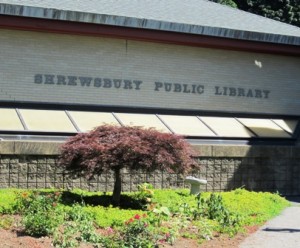By Doris Christelis, Contributing Writer
 Shrewsbury – The Shrewsbury Public Library was recently transformed into a voyage on the Titanic for 80 lucky “passengers.” Ticketholders holding “steerage” and “first class” tickets enjoyed a walking tour through the library, which had been transformed into different rooms of the Titanic in commemoration of Archaeology Month, which was October.
Shrewsbury – The Shrewsbury Public Library was recently transformed into a voyage on the Titanic for 80 lucky “passengers.” Ticketholders holding “steerage” and “first class” tickets enjoyed a walking tour through the library, which had been transformed into different rooms of the Titanic in commemoration of Archaeology Month, which was October.
The tour, designed to educate and immerse the visitors in the Titanic's history, appealed to a broad range of adults and children who were able to step back in time to 1912.
“Since 2012 is the 100th anniversary of the sinking of the Titanic, a tour seemed a good fit,” said Sharon Martin, Head of Children's Services at the Shrewsbury Public Library.
After entering the “ship,” “passengers” were greeted by a model of the Titanic built by Dean Gillam, who also volunteered that night in the ship's boiler room. Tours led by Martin and Dan Barbour, the young adult librarian and volunteer coordinator, then proceeded past a model iceberg with photos of the real icebergs found in the vicinity of the ship's sinking. One of the icebergs had a smear of red paint on its base and it was thought that it was the one that the Titanic struck.
Throughout the tour, analogies to Shrewsbury were made. For example, while the library is 50 feet high, the 3,000-year-old iceberg that the Titanic struck was thought to be 50 to 100 feet high. “Passengers” also learned that the Titanic was as long as the distance between the library and the Town Hall, and that the last survivor of the Titanic, Lillian Asplund, died in Shrewsbury in 2006 at the age of 99.
In a room called “Titanic by the Numbers,” “passengers” learned many interesting facts including how the ship that took three years to build sank in under three hours, and that three lap dogs survived, while so many passengers perished. Also interesting was that the hull of the Titanic was only three-quarter inch thick while most “passengers” in Shrewsbury guessed it was at least one foot thick.
Further along in the tour, “passengers” were able to visualize how big the average lifeboat was by tape marked out on a rug in the shape of a lifeboat. By putting the average number of passengers that had, in 1912, made their way onto one of the Titanic's lifeboats, visitors were able to visualize how much room remained on each lifeboat and could easily imagine how many more lives could have been saved had the boats been filled to capacity.
Other rooms with volunteers re-enacting members of Titanic's crew included the “Marconi Room” where wireless operators were the first to communicate that the Titanic was sinking to 25 ships in the area using Morse Code, including the Carpathia which was the first ship to respond although it was not the closest.
In the “ship's” dining room, visitors were able to dine on items from the Titanic's actual menu on the day of the sinking – chocolate éclairs that had been served in the first-class dining rooms, and “Cabin biscuits,” a staple in steerage.
Those interested in more information on the Titanic are welcome to visit the Shrewsbury Public Library, where many books are available on the subject.














